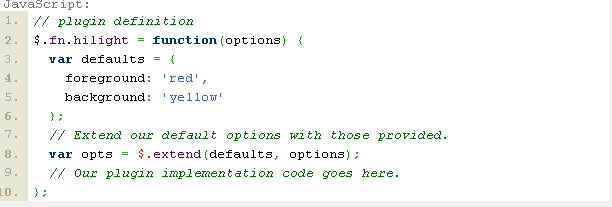Heim >Web-Frontend >js-Tutorial >一步一步教你写一个jQuery的插件教程(Plugin)_jquery
一步一步教你写一个jQuery的插件教程(Plugin)_jquery
- WBOYWBOYWBOYWBOYWBOYWBOYWBOYWBOYWBOYWBOYWBOYWBOYWBOriginal
- 2016-05-16 18:47:121088Durchsuche
jQuery 的plugin开发需要注意的事情,
1. 明确jQuery的命名空间只有一个。
2. 明白options参数用来控制plugin的行为。
3. 为默认的plugin设定提供公共的访问权限。
4. 为子函数提供公共的访问权限。
5. 私有的函数绝对是私有访问
6. 支持metadata plugin。
我将会在下面的例子中一个一个的说明上面这几个条件,做完这些事情后我们就会创建一个高亮显示text的简单插件。
1. 明确jQuery的命名空间只有一个
在我们的例子里,我们将会命名这个插件名字为hilight,

也就是我们的plugin可以通过下面的方法来使用:

为什么jQuery的plugin只有一个命名空间?可能是设计的要求,或者是这样的话可读性更强,亦或是为了面向对象的设计模式。
2.明白options参数来控制plugin的行为。
让我们先为我们的hilight插件明确一下foreground和background的颜色。我们应该能够允许这两个option作为option对象传递给plugin的主函数。例如:

现在插件能够设定如下的属性:

3. 为默认的plugin设定提供公共的访问权限。
我们这里可以改进一下,就是让上面的代码能够设置能够扩展。这样当使用这个插件的用户能够使用最少的代码重载我们的option。这也就是我们开始使用function对象的好处。

现在用户可以在他们的script中使用一行代码来设置foreground属性:

有了上面的代码我们就可以把某个DOM控件的foregrounf颜色设定为blue了。

4. 为子函数提供公共的访问权限
这个条款和上面的相仿,能很有趣的让你的Plugin有扩展功能。例如:在lilight的plugin中我们能够定义一个function是format,可以定义hilight的text的形式。我们的plugin代码将会显示如下:

这里我们可以很容易支持另外的一个option对象来通过一个callback 函数来重载默认的formatting。那将会是另外一个不错的支持自定义的方式。
5. 私有的函数绝对是私有访问
公开plugin的一些Option能够被自定义当然是个非常强大的功能。但是你需要考虑哪部分应该被公开,哪部分不应该通过外部访问,否则会破会你已经封装好的结果。

这里debug方法不能从外部访问,因为他在plugin的展现中属于私有的方法。
6.支持metadata plugin。
使用Metadata Plugin需要看你的plugin是什么类型,可能它会使你的插件功能更加强大。个人来说,我比较喜欢metadata plugin是因为它能偶让我的plguin的option通过标记重载。

如果metadata plugin能够成功的封装到我们的插件,那么可以通过下面的标记来使用这个lilight插件。

最终代码如下:
//
// create closure
//
(function($) {
//
// plugin definition
//
$.fn.hilight = function(options) {
debug(this);
// build main options before element iteration
var opts = $.extend({}, $.fn.hilight.defaults, options);
// iterate and reformat each matched element
return this.each(function() {
$this = $(this);
// build element specific options
var o = $.meta ? $.extend({}, opts, $this.data()) : opts;
// update element styles
$this.css({
backgroundColor: o.background,
color: o.foreground
});
var markup = $this.html();
// call our format function
markup = $.fn.hilight.format(markup);
$this.html(markup);
});
};
//
// private function for debugging
//
function debug($obj) {
if (window.console && window.console.log)
window.console.log('hilight selection count: ' + $obj.size());
};
//
// define and expose our format function
//
$.fn.hilight.format = function(txt) {
return '' + txt + '';
};
//
// plugin defaults
//
$.fn.hilight.defaults = {
foreground: 'red',
background: 'yellow'
};
//
// end of closure
//
})(jQuery);
In Verbindung stehende Artikel
Mehr sehen- Eine eingehende Analyse der Bootstrap-Listengruppenkomponente
- Detaillierte Erläuterung des JavaScript-Funktions-Curryings
- Vollständiges Beispiel für die Generierung von JS-Passwörtern und die Erkennung der Stärke (mit Download des Demo-Quellcodes)
- Angularjs integriert WeChat UI (weui)
- Wie man mit JavaScript schnell zwischen traditionellem Chinesisch und vereinfachtem Chinesisch wechselt und wie Websites den Wechsel zwischen vereinfachtem und traditionellem Chinesisch unterstützen – Javascript-Kenntnisse

